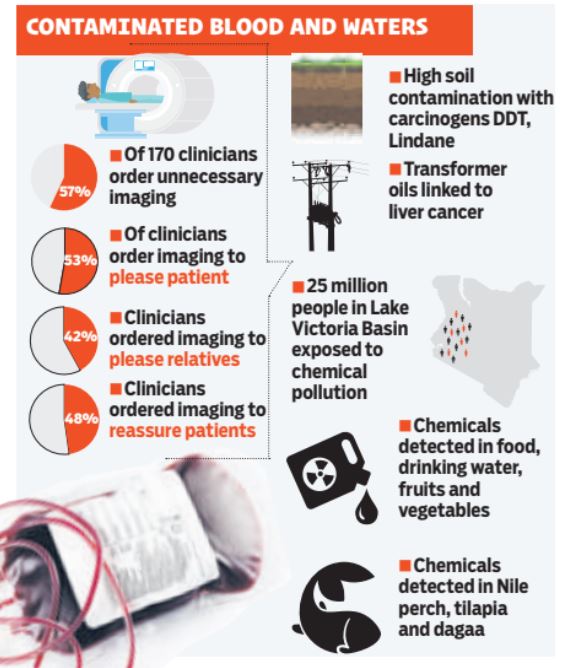
Some of the blood transfused in hospitals is contaminated with dangerous substances. This chilling admission by insiders at the blood transfusion centre comes amid reports that some patients were being dangerously exposed to cancer causing radiation, while most soils and Lake Victoria water are contaminated with toxic chemicals.
The latest evidence by staff of the Nairobi Regional Blood Transfusion Centre (NRBTC) published early this month found blood prepared for transfusion contaminated with disease-causing germs.
The report, appearing in the current issue of the East African Medical Journal, says 12 per cent of 91 tested samples were contaminated with bad bacteria. Led by Margret Kemunto Onchaga, the study identified germs included the highly dangerous S. aureus, which can cause blood poisoning, pneumonia, meningitis, bone and heart infections or fatal toxic shock syndrome.
Also identified in the blood was the bacterium P. paucimobilis associated with septic shock, meningitis, and urinary tract and wound infections.

Best standards
Last year, the same team reported 18 per cent of tested samples of platelets concentrates had failed to meet required standards. Platelets concentrates are prepared from whole blood and used to treat patients with clotting disorders and some cancers.
Last year, a scientific study had reported blood at the national bank to be highly contamination with HIV and syphilis. The study, though dismissed by the government, is still available on the Internet. The blood bank’s head of Communication Kamotho Makara said they have already commissioned a new study to validate the findings indicating contamination of blood at the Nairobi centre.
“We can’t ignore such findings. We have commissioned a new study to establish their validity,” Makara told Saturday Standard on Thursday.
He said the bank takes quality very seriously and assured Kenya’s of the safety of their products and services. However, the authors want the bank’s quality assurance protocols reviewed to ensure blood safety and quality.
In the same journal issue, patients and staff at the Kenyatta National Hospital (KNH) were reported to be dangerously exposed to cancer causing radiation. The study indicates that only a handful of clinicians prescribing diagnostic imaging to patients have the basic knowledge of the modalities of radiation.
The study involving 170 clinicians at KNH found almost half of them are likely to send patients for needless radiation diagnosis. Almost 60 per cent of the doctors were found to refer patients for imaging even where not necessary.
Highest among reasons for doing so, says lead investigator Dr Wendy Gecaga is to make the patient feel they are being taken seriously or fulfill the patient’s or relatives’ expectations. “The implications here are serious for the patient as they are possibly being exposed to unnecessary radiation and its attendant risks, which include carcinogenesis,” warns the study.
These reports also coincide with the World Health Organisation (WHO) 2018 global data on cancer released in September that showed a disease on the match. In Kenya, WHO said cancer deaths had a 20 per cent jump from 27,000 in 2012 to 32,900 in 2018 from 47,887 annual cases.
In the same week the Sino-Africa Joint Research Centre, involving Kenya and Chinese researchers published data showing high contamination of local agriculture soils.
The team had sampled soils at various points between Kiambu and Mombasa and found high contamination with cancer causing chemicals. “We identified recent and historical use of DDTs and Lindane in collected samples,” says the study published in the Bulleting of Environmental Contamination and Toxicology. Both DDT and Lindane are classified carcinogenic or cancer causing agents by the WHO and their use banned or restricted. In 2015, WHO confirmed Lindane, a popular hair and skin shampoo, also used in agricultural as a cancer-causing agent. An earlier study among women at a maternity hospital in Nairobi carried out by Shem Wandiga of the University of Nairobi found significant levels of Lindane in breast milk collected from the mothers. The new study found high soil contamination from electricity transformer oils due to the increasing electrification in the country and poor waste disposal.
Transformer oils belong to a group of chemicals called PCBs, which have been linked to reproductive problems in women and liver cancers.
Detailed report
But perhaps most worrying is a detailed report of the United Nations and the East African Community published early this month.
Due to preventable water pollution, the report says the 25 million people living on the Kenyan side of the Lake Victoria Basin are facing serious health consequences. The report demonstrates that crucial parts of Lake Victoria, rivers Mara, Nyando, Yala, Gucha and Sondu-Miriu - all draining to the lake are highly polluted with chemicals. Dangerous chemical, the report says have been detected in food, drinking water supplies as well as in export products such as fish, fruits and horticultural produce. “Some contaminants have also been detected in edible parts of the three most common fish species Nile perch, tilapia and dagaa within the basin,” says the report.
Pesticide use in the region, are blamed for a 40 per cent decline of pollinating bees, 18 per cent of butterflies and a 10 per cent wildlife mortalities in the basin. In September a man in California, US, was awarded Sh30b after he developed cancer which has been blamed on the pesticide Glyphosate.
The report says pollutants in the Lake Basin are mainly from agricultural, pharmaceutical, domestic waste and industrial sources. However, the report warns of increasing pollution from chemicals used in a booming beauty industry.
Present and resultant health problems, the report says are increased cancers, heart and respiratory diseases, allergies, genetic changes and childhood illnesses. Out of the 14 commonly used pesticides in Nyando catchment for example, 14.3 per cent are classified by WHO as highly hazardous; 50 per cent as moderately hazardous and 35.7 per cent as slightly hazardous.
 The Standard Group Plc is a multi-media organization with investments in media platforms spanning newspaper print
operations, television, radio broadcasting, digital and online services. The Standard Group is recognized as a
leading multi-media house in Kenya with a key influence in matters of national and international interest.
The Standard Group Plc is a multi-media organization with investments in media platforms spanning newspaper print
operations, television, radio broadcasting, digital and online services. The Standard Group is recognized as a
leading multi-media house in Kenya with a key influence in matters of national and international interest.











